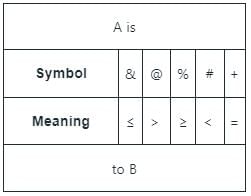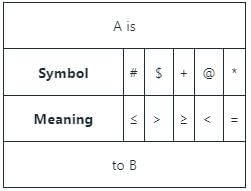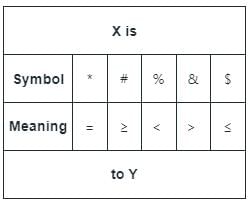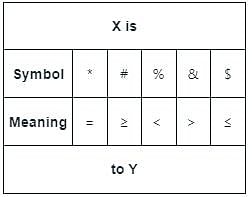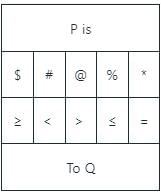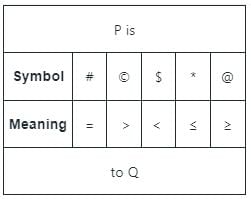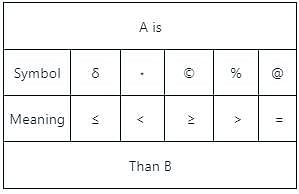MCQ Test: Coded Inequalities - Bank Exams MCQ
15 Questions MCQ Test Reasoning Aptitude for Competitive Examinations - MCQ Test: Coded Inequalities
The symbols a, f, #, ⋆ and ∞ are used with the following meanings :
R a S implies that R is greater than S.
R f S implies that R is lesser than S.
R # S implies that R is equal to S.
R ⋆ S implies that R is either greater than or equal to S.
R ∞ S implies that R is either lesser than or equal to S.
Based on the above statements, answer the following :
Statements :
M a N, O f M, M ∞ P
Conclusions :
I. M ⋆ P
II. O f P
R a S implies that R is greater than S.
R f S implies that R is lesser than S.
R # S implies that R is equal to S.
R ⋆ S implies that R is either greater than or equal to S.
R ∞ S implies that R is either lesser than or equal to S.
Based on the above statements, answer the following :
Statements :
M a N, O f M, M ∞ P
Conclusions :
I. M ⋆ P
II. O f P
Direction: In the following question assuming the given statement to be true, find which of the conclusion among given conclusions is/are definitely true and then give your answers accordingly.
‘A & B’ means ‘A is either smaller than or equal to B.’
‘A @ B’ means ‘A is neither smaller than nor equal to B.’
‘A % B’ means ‘A is either greater than or equal to B.’
‘A # B’ means ‘A is neither greater than nor equal to B.’
‘A + B’ means ‘A is neither greater than nor smaller than B.’
Statements: A % D @ G + H # C; B & F @ C + E
Conclusions:
I. A @ E
II. G # F
‘A & B’ means ‘A is either smaller than or equal to B.’
‘A @ B’ means ‘A is neither smaller than nor equal to B.’
‘A % B’ means ‘A is either greater than or equal to B.’
‘A # B’ means ‘A is neither greater than nor equal to B.’
‘A + B’ means ‘A is neither greater than nor smaller than B.’
Statements: A % D @ G + H # C; B & F @ C + E
Conclusions:
I. A @ E
II. G # F
| 1 Crore+ students have signed up on EduRev. Have you? Download the App |
The simple interest accrued on a sum of certain principal is Rs. 1200 in 4 years at the rate of 8% per annum. What would be the simple interest accrued on thrice of that principle at the rate of 6% per annum in 3 years?
Comprehension:
Direction: Study the information given carefully and answer the question given below.
‘A # B’ means ‘A is either smaller than or equal to B.’
‘A $ B’ means ‘A is neither smaller than nor equal to B.’
‘A + B’ means ‘A is either greater than or equal to B.’
‘A @ B’ means ‘A is neither greater than nor equal to B.’
‘A * B’ means ‘A is neither greater than nor smaller than B.’
Statement: S @ T $ Q + R; Q * P @ W
Conclusion:
I) R # W
II) W $ R
Comprehension:
Direction: Study the information given carefully and answer the question given below.
‘A # B’ means ‘A is either smaller than or equal to B.’
‘A $ B’ means ‘A is neither smaller than nor equal to B.’
‘A + B’ means ‘A is either greater than or equal to B.’
‘A @ B’ means ‘A is neither greater than nor equal to B.’
‘A * B’ means ‘A is neither greater than nor smaller than B.’
Statement: S @ T $ Q + R; Q * P @ W
Conclusion:
I) R # W
II) W $ R
III) R @ T
Comprehension:
Direction: In the following questions, the symbols *, #, %, & and $ are used with the following meaning as illustrated below:
‘X * Y’ means ‘X is neither less than nor greater than Y’.
‘X # Y’ means ‘X is either greater than or equal to Y’.
‘X % Y’ means ‘X is less than Y’.
‘X & Y’ means ‘X is neither less than nor equal to Y’.
‘X $ Y’ means ‘X is not greater than Y’.
Now in each of the following questions assuming the given statements to be True, find which of the conclusion/s given below them is/are definitely True?
Statements:
A % B, C & D, F * E # C, D % A
Conclusions:
I. D % B
II. E & A
III. F & D
Comprehension:
Direction: In the following questions, the symbols *, #, %, & and $ are used with the following meaning as illustrated below:
‘X * Y’ means ‘X is neither less than nor greater than Y’.
‘X # Y’ means ‘X is either greater than or equal to Y’.
‘X % Y’ means ‘X is less than Y’.
‘X & Y’ means ‘X is neither less than nor equal to Y’.
‘X $ Y’ means ‘X is not greater than Y’.
Now in each of the following questions assuming the given statements to be True, find which of the conclusion/s given below them is/are definitely True?
Statements
Q & P, Y * U, D % P, Y # D
Conclusions:
I. U * D
II. D $ U
III. D & U
In the following questions, the symbols $, #, @, % and * illustrate the following meanings.
- P $ Q - P is not smaller than Q
- P # Q - P is neither greater than nor equal to Q.
- P @ Q - P is neither smaller than nor equal to Q.
- P % Q - P not greater than Q
- P * Q - P is neither greater than nor smaller than Q
Statements:
K # L, L % M, M * N, N # O
Conclusions:
I. K # M
II. K * M
III. L % O
Directions: In the following question assuming the given statements to be true, find which of the conclusion among given conclusions is/are definitely true and then give your answers accordingly.
Statements: H > F ≤ O ≤ L; F ≥ V < D
Conclusions:
I. L ≥ V
II. O > D
Directions: In the following question assuming the given statements to be true, find which of the conclusion among given conclusions is/are definitely true and then give your answers accordingly.
Statements: E > R < T, V > Z ≥ K = T
Conclusions:
I. V < E
II. R < Z
Directions: In these types of questions the symbols $, *, @, ©, # are used with the following meanings as illustrated below:
‘P$Q’ means ‘P is smaller than Q’
‘P©Q’ means P is greater than Q’
‘P#Q’ means P is equal to Q’
‘P@Q’ means P is either equal to or greater than Q
‘P*Q’ means P is either equal to or less than Q
Now in each of the following questions assuming the given statements to be True, find which of the conclusion/s given below them is/are definitely True?
Statements:
B © C # D @ X; E * X; D @ Z
Conclusions:
I. B © E
II. Z @ B
Read the given statement and conclusions carefully. Decide which of the given conclusions is/are true based on the given statement.
Statement:
Z > H ≥ Y > R < D ≥ F > X
Conclusions:
I. Z ≥ X
II. F > H
Directions: In the following question, the symbols δ, @, ©, % and ⋆ are used with the following meaning as illustrated below.
‘A © B’ means ‘A is not smaller than B’.‘A % B’ means ‘A is neither smaller than nor equal to B ’.‘A ⋆ B’ means ‘A is neither greater than nor equal to B’.‘A δ B’ means ‘A is not greater than B’.‘A @ B’ means ‘A is neither greater than nor smaller than B’.
Now in each of the following questions assuming the given statements to be true, find which of the four conclusions I, II, II and IV given below them is / are definitely true and give your answer accordingly.
Statements:
A © B, C © B, D % C
Conclusions:
I. B % D
II. C @ A
III. D @ A
IV. B ⋆ D
In the question two statements are given, followed by two conclusions, I and II. You have to consider the statements to be true even if it seems to be at variance from commonly known facts. You have to decide which of the given conclusions, if any, follows from the given statements.
Statements:
P = U < M < K ≤ I > N
Conclusions:
I. N ≥ K
II. I > P
Directions: In the following question assuming the given statements to be true, find which of the conclusion among given conclusions is/are definitely true and then give your answers accordingly.
Statements: G < R = T ≤ P, V > R > S
Conclusions:
I. V > P
II. P > S
|
11 videos|20 docs|171 tests
|
|
11 videos|20 docs|171 tests
|


